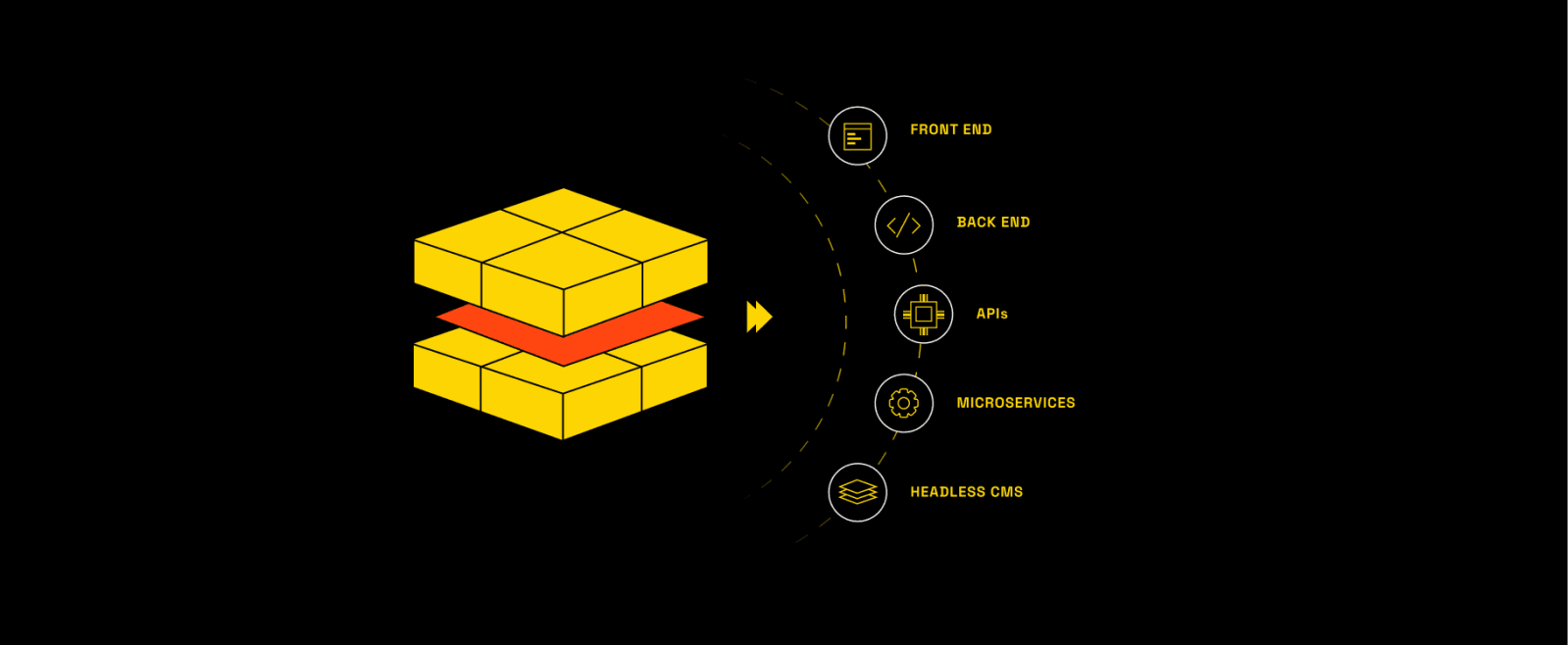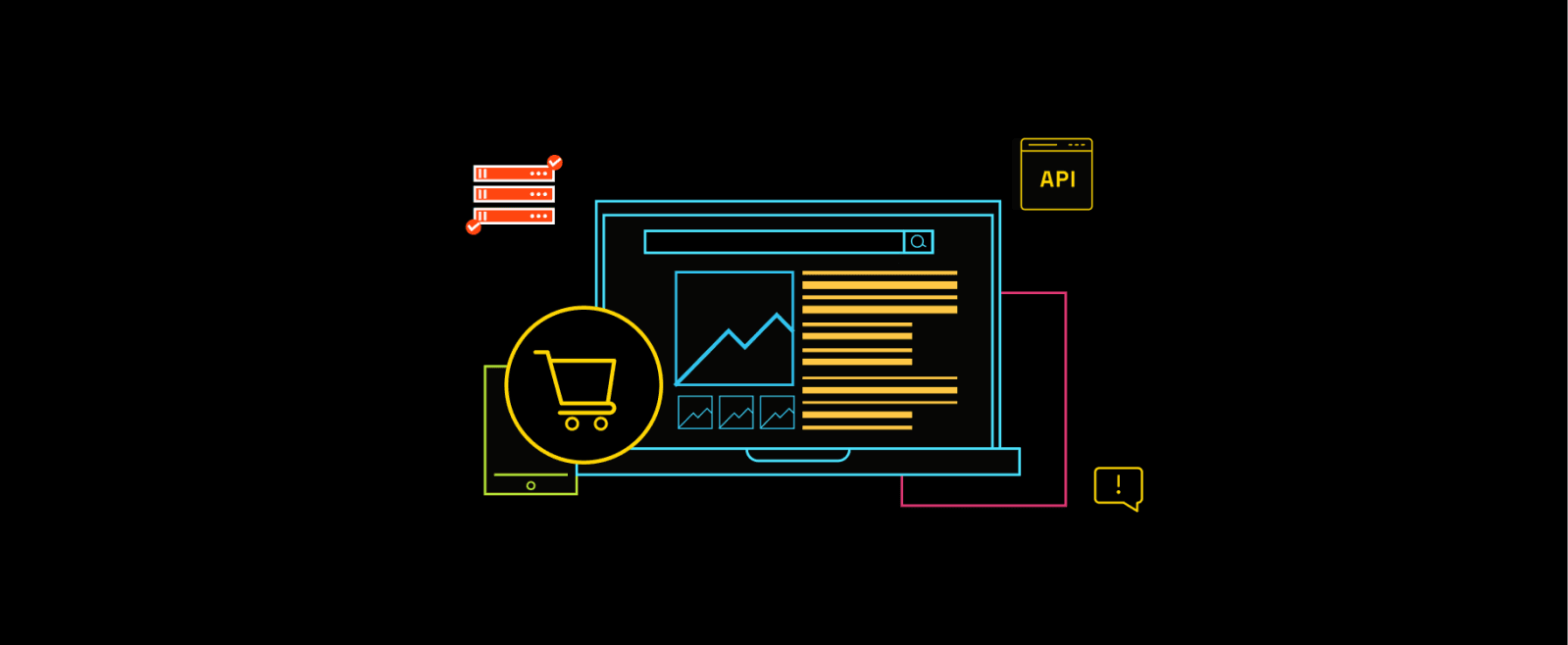Composable Commerce Architecture: How B2C, B2B, and DTC Brands Build Modular Systems That Scale
Composable commerce architecture gives modern retailers a way to scale, adapt, and innovate—without rebuilding their entire stack.
This guide is for CTOs, solution architects, and platform leads who aren’t asking “why composable?”—they’re focused on how to structure it, govern it, and make it deliver business value.
We’ll break down the core layers of composable commerce architecture, how modular services work together, and what B2C, B2B, and DTC brands are doing to build API-first systems—from carts and PDPs to quoting tools and CDP orchestration.
Composable Commerce Architecture: Principles, Stack, and System Design
Composable commerce architecture breaks commerce into modular, API-connected services—PDPs, checkout, pricing, search—each deployable and scalable on its own. This flexibility helps enterprise retailers escape vendor limitations and modernize without replatforming entirely.
Core Architecture Layers
The system architecture consists of four primary layers with distinct responsibilities:

The frontend layer supports headless delivery across web, app, and emerging channels—each consuming the same API foundation. B2C brands optimize this layer for UX and personalization velocity, while B2B teams may extend it with CPQ or portal interfaces for logged-in experiences.
The orchestration layer routes API traffic, manages event flows, and connects frontend experiences with backend logic. This is often a combination of API gateway tools (e.g., AWS API Gateway), GraphQL query layers, and event brokers—all wired to support real-time sync and fallback across services.
Though technically frontend orchestration, platforms like Vue Storefront unify integrations across decoupled backend services—especially for multi-brand retail sites.
The Services layer contains domain-specific microservices encapsulating business logic. The Data layer manages persistence and data access patterns.
Enterprise architectures often coordinate 10+ vendor services across the stack—from Stripe (payments) and Algolia (search) to Braze (engagement) and Segment (CDP).
The orchestration layer governs how these tools are secured, versioned, and synchronized—enabling development teams to deploy new features in parallel, marketing teams to run campaigns without engineering delays, and operations teams to isolate and resolve issues faster.
This vendor coordination is what makes composable architecture scalable—not just technically modular, but operationally agile across B2C, B2B, and DTC needs.
| Layer | B2C Focus | B2B Focus | DTC Focus |
|---|---|---|---|
| Frontend | Personalization velocity, mobile-first | Portal UX, account-based logic | Launch speed, channel testing, frequent design iterations, promo responsiveness |
| Orchestration | API gateway + event-driven flows | Complex backend coordination (ERP, CPQ) | Quick plug-and-play for tools |
| Services | Promotions, PDPs, cart logic | Quoting, order workflows | Bundles, CRM sync |
| Data | Real-time inventory & pricing | Contract pricing, tiered catalogs | Fast PIM/CDP iteration |
Service Contracts and API Design
Service contracts define how each component communicates within a composable system—making interoperability predictable and scalable. A well-formed contract ensures that every service adheres to consistent communication standards, even when developed independently. Key design principles include:
-
Schema validation and strong typing, to avoid miscommunication between systems
-
Versioning via URI paths (e.g. /v1/products), to enable iterative updates without breaking dependencies
-
Standardized error handling, so downstream systems know how to respond
-
Security and rate-limiting policies, often enforced at the gateway level
-
Event-driven patterns, which support async updates for real-time experiences like inventory or pricing
The orchestration layer—via tools like AWS API Gateway or Azure API Management—enforces these contracts and manages:
-
Request routing and protocol translation
-
Authentication, authorization, and throttling
-
Request/response transformations and caching
These API contracts are what uphold real-time expectations across the stack.
-
For B2C, this means PDP responses under 200ms during high-traffic promotions.
-
For B2B, uptime guarantees on pricing and quoting APIs are critical for RFQ systems and contractual pricing logic.
-
For DTC, contracts support faster experimentation across A/B variants, promotions, and personalized PDP delivery—without risking stability downstrea
Cloud-Native Implementation
Composable commerce architecture relies on cloud-native patterns to support modular deployment, elasticity, and fault tolerance. Key implementation patterns include:
-
Containerized service deployment (e.g., Docker + Kubernetes)
-
Auto-scaling infrastructure that adjusts to service-level traffic
-
Service mesh architecture (e.g., Istio) for routing, retries, and observability
-
Distributed caching to reduce API load (e.g., Redis, CDN edge caching)
-
Event-driven messaging (e.g., Kafka, SNS/SQS) for decoupled operations
These patterns allow each commerce function—search, checkout, pricing, fulfillment—to scale independently.
-
B2C brands can isolate and optimize performance during high-volume events like seasonal drops.
-
B2B systems benefit from elastic resources on quoting or availability logic, especially when synced with ERPs.
-
DTC teams leverage this flexibility to test channels, campaigns, or new services quickly—rolling them back without full-stack reverts.
Composable vs Monolithic Architecture: Technical Stack Comparison
Monolithic systems centralize everything—from product data to checkout logic—into a single codebase. This simplifies the initial setup but slows teams down over time. Composable architecture takes the opposite approach: break commerce into modular services that evolve independently and scale with business needs.
This section breaks down key architectural differences—from deployment models to performance and experimentation workflows—so you can evaluate what fits your team’s velocity, complexity, and scale requirements.
System Architecture and Deployment Models
In a composable architecture, each commerce capability—like search, pricing, or checkout—runs as an independently deployable service. Teams can update the search engine without touching the checkout flow. They can A/B test pricing logic without waiting on frontend rebuilds. This is typically enabled by container orchestration (e.g., Kubernetes), where each service scales based on its traffic profile.
Key characteristics:
-
Modular deployment through service containers
-
Independent scaling based on actual demand
-
Shorter release cycles and service-specific test environments
-
Poly-cloud flexibility, choosing infrastructure per service
In contrast, monolithic platforms bundle all functions into a single deployable unit. Even small updates—like adding a new payment method—require testing and deploying the entire system. This slows innovation, increases risk, and often results in bloated QA cycles. Legacy Magento implementations are a prime example: altering checkout logic often means touching unrelated areas like product listing or promo rules.
Integration Patterns: Sync, Async, and Event-Driven Models
One of the most transformative shifts in composable commerce architecture is how systems communicate. Instead of tight, synchronous coupling where every service waits on another, composable stacks enable loosely coupled, asynchronous, and event-driven communication.
In composable architecture:
-
Inventory updates are decoupled from checkout. A stock update delay doesn’t block transactions.
-
Product catalog updates can be published via events, letting frontend caches, search indexes, and merchandising systems update independently.
-
Message queues (like Kafka, RabbitMQ, or AWS SQS) absorb traffic spikes and smooth load distribution across services.
-
API contracts enable microservices to communicate with clarity and resilience—using retry logic, throttling, and fallback mechanisms when needed.
This means services can fail gracefully or update independently—essential for peak shopping windows, real-time experimentation, or campaign launches tied to third-party APIs.
In contrast, monolithic systems:
-
Depend heavily on synchronous request chains—where one service’s delay can cascade through the entire stack.
-
Updates to search or pricing often require touching central services, increasing regression risks.
-
Struggle under load when one tightly-coupled service (e.g., inventory or promotions) becomes a bottleneck.
For enterprise B2C and B2B brands, adopting asynchronous and event-driven integration models isn’t just about speed—it’s about fault tolerance, release independence, and system resilience at scale.
Scaling, Monitoring, and Maintenance Differences
Composable architecture shifts scalability from system-wide to service-specific—giving teams precise control over where to allocate resources and when.
-
Search services can scale independently during seasonal spikes (e.g. Black Friday), without increasing capacity for unrelated systems like returns or loyalty.
-
Checkout APIs can be replicated globally to maintain latency benchmarks under peak concurrency.
-
Monitoring tools (e.g., Datadog, New Relic, OpenTelemetry) are configured per service, enabling root-cause tracing and threshold-based alerting at the component level.
This granular observability allows ops teams to isolate performance regressions faster and deploy targeted fixes—something not possible in tightly coupled monolithic systems.
In contrast:
-
Monolithic systems require vertical scaling—scaling everything (search, checkout, PDPs) even if only one service needs capacity. This results in higher TCO and slower response to traffic surges.
-
Maintenance windows are system-wide, forcing downtime or code freezes across all services, often leading to delayed releases and stacked dependencies.
While composable monitoring and alerting require a higher upfront investment in tooling and telemetry design, they pay off with:
-
Shorter incident resolution times
-
More accurate capacity planning
-
Fewer false positives in production monitoring
As BetterCommerce reports, brands moving to composable have seen infrastructure cost reductions of up to 30%, largely due to this ability to scale only what’s necessary—when it’s necessary.
Building a Composable Commerce System: Core Components Explained
A composable commerce system consists of independent, specialized services working together through well-defined APIs. Let's break down the core components and their implementation considerations.
Commerce and Experience Services
Composable commerce stacks are built from modular, best-of-breed services across core and experience layers. Selecting the right tools isn’t just about functionality — it’s about API maturity, scale-readiness, and governance alignment.
-
PIM → Opt for solutions that support real-time sync, localized schema support, and bulk update APIs—especially important for managing large catalogs, product variants, or frequent pricing changes in B2B and omnichannel retail.
-
CMS → A headless CMS should support structured content modeling, localization layers, and GraphQL/REST APIs to serve personalized content across storefronts, apps, and portals—especially as content orchestration moves beyond just marketing.
-
Search → Prioritize search services with pre-built AI ranking models and real-time indexing support. In composable, latency from search impacts cart adds and bounce rates directly.
-
Cart & Checkout → Look for checkout providers with server-side rendering (SSR), built-in PCI-DSS compliance, and robust promotion engines. B2C and DTC brands often experiment across markets—so the service should support A/B testing, logic branching, and fallback states without over-relying on frontend overrides.
Leading implementations often stack solutions like Contentstack (CMS), Algolia (search), and Shopify Plus (via Hydrogen) or Salesforce CC as the commerce engine.
What sets high-performing brands apart is how they design service interactions—from how search and checkout talk to each other, to how cart logic responds to promotion toggles—without bottlenecking teams across markets or touchpoints.
Commerce Orchestration Platforms
In composable commerce, orchestration platforms are the operational nerve center that synchronizes business-critical flows across decoupled services. Unlike traditional integrations, these platforms enable real-time coordination between pricing engines, fulfillment systems, search services, and customer data platforms—all through centralized logic layers.
Key capabilities include:
-
Workflow orchestration — managing flows like order routing, inventory sync, refund triggers, or loyalty updates across multiple services (OMS, ERP, CRM, etc.).
-
API integration and event management — standardizing how third-party systems (e.g., Stripe, Rebuy, Gorgias) interact with core commerce services.
-
Business logic centralization — allowing operations, CX, and marketing teams to update campaign logic, bundling rules, or fulfillment paths without deep engineering changes.
-
Operational visibility — offering service-level logs, retry logic, and health tracking to ensure issues are isolated and resolved without system-wide impact.
-
Enterprise brands typically integrate orchestration platforms like Elastic Path Commerce Cloud, Vue Storefront Middleware, or Fabric’s experience orchestration layer to reduce time-to-market for new experiences and de-risk custom integrations.
💡Tip: Orchestration platforms should not become bottlenecks themselves. Choose tools that support distributed execution and event-driven architectures, rather than relying solely on request/response chaining.
Integration and Data Abstraction Layers
In composable architecture, the integration and data abstraction layers sit between decoupled services, acting as the connective tissue for secure, reliable communication.
The integration layer acts as the real-time translator between services—standardizing how pricing, inventory, search, and personalization work across teams, vendors, and tools.
-
API gateways (e.g., AWS API Gateway, Kong) that standardize authentication, route requests, and enforce rate limits.
-
Event buses (e.g., Kafka, EventBridge) to enable non-blocking, asynchronous operations like inventory syncs or order status updates.
-
Data transformers to reconcile formats across systems—especially critical when connecting legacy ERPs, CRMs, and PIMs.
-
Caching logic that reduces backend load and accelerates API responses for high-traffic endpoints like search or pricing.
The data abstraction layer simplifies how internal services consume external data. It creates:
-
Clear service contracts that define what data is exposed and expected.
-
Unified models across domains (e.g., product, pricing, customer) to reduce data silos.
-
Event-driven triggers that enable real-time personalization, promotions, or CX automation.
-
Fallback mechanisms to ensure business continuity even if a service becomes temporarily unavailable.
Frontend Frameworks and Rendering Options
The frontend stack in composable architecture is designed for speed, independence, and control—without tying UX decisions to backend update cycles. Most enterprise implementations adopt a hybrid rendering strategy:
-
Server-side rendering (SSR) for SEO-critical and high-conversion pages like PLPs and PDPs
-
Static site generation (SSG) for marketing content and seasonal campaigns
-
Client-side rendering (CSR) for dashboards, personalization layers, and dynamic forms
Frameworks like Next.js (React) and Nuxt (Vue) offer flexible support for all three modes. Teams also implement micro-frontend architectures, enabling separate ownership of pages or components—like checkout, account pages, or category navigation.
Each micro-frontend is:
-
Independently deployable, with its own CI/CD pipeline
-
Connected to backend services through lightweight API clients
-
Built with modular state management for real-time data sync across services (e.g., pricing, inventory, personalization)
💡For B2C/DTC brands, this means faster experiments on PDPs or promos without risking sitewide outages.
For B2B, it supports role-based portals and workflow-specific UI updates that evolve independently.
Ultimately, the frontend layer becomes its own product—capable of fast iteration, channel-specific UI delivery, and resilience under load.
How to Implement Composable Architecture: Planning, Domains, and Governance
For enterprise commerce teams, success depends on how well composable commerce implementation strategy aligns with business priorities. That means sequencing the right domains, enabling parallel deployment paths, and building a governance foundation that supports fast iteration without compromising reliability.
Key Engineering Concepts for Composable Planning
Phased Domain Decoupling:
Break down your commerce stack by business capabilities—like search, PDP, pricing, checkout—then prioritize based on business impact and decoupling feasibility. Most brands begin with high-ROI domains that are relatively self-contained and directly tied to revenue velocity. This sequencing helps minimize disruption while delivering visible wins fast.
Feature Toggles for Controlled Rollouts:
Don’t just launch new services—test them. Feature toggles let you expose new capabilities gradually across campaigns, devices, or geographies without hard commits. For example, B2C brands can toggle in a new checkout flow for a small user segment during peak sales to validate conversion lift before scaling. In B2B, it allows gated rollouts for specific account tiers.
Polyrepo Strategies for Parallel Development:
In composable systems, independence matters. Structuring services into individual repos helps decouple release cycles, enabling faster iteration per domain. For instance, your PDP team can ship frontend changes without waiting on cart or promotions updates—crucial when running rapid campaign iterations or launching seasonal storefronts.
Platform Engineering for Commerce Outcomes:
Composable architecture needs more than microservices. CI/CD pipelines, observability, and service discovery form the platform backbone that enables velocity at scale. But don’t get lost in tooling—connect platform decisions back to commerce goals. For example, a service mesh should improve uptime for checkout APIs during flash sales, not just tick a DevOps checkbox.
Prioritizing Domains and Defining Scope
Don’t start everywhere. Start where it pays off. Break down your monolith by identifying business domains with the highest potential return—measured in conversion gains, operational lift, or market speed. Evaluate using these criteria:
-
Business Value: Prioritize flows like search, cart, or PDPs—where even a 1-second performance gain drives conversion.
-
Decoupling Complexity: Map dependencies before breaking things apart. PDPs and search are often self-contained; checkout and promotions less so.
-
Org Readiness: Is your frontend team already building headless UIs? Is your dev cycle modular today? Start where momentum already exists.
-
Operational Risk: What happens if this service goes down? Start with components where failure has the least downstream impact.
Product catalog and search are smart starting points. They’re high-frequency, low-coupling services that support personalization and merchandising agility—without disrupting core transactions like checkout.
Coexistence with Legacy: APIs, Middleware, and Sync Layers
During phased rollouts, composable services need to run in parallel with existing monolith systems—without breaking data flows, uptime, or team workflows.
To enable this, focus on operational coexistence, not just technical decoupling:
-
API Gateway Layer: Acts as the unified control point between new and old services. Helps abstract legacy logic behind standardized endpoints—critical when frontend teams begin consuming composable services.
-
Event Bus: Facilitates real-time sync between systems. For example, when inventory updates in the monolith, the same data should trigger updates across composable services like PDPs or search indexes.
-
Sync Services: These middleware components manage bidirectional data flows and reconcile conflicts—especially for pricing, inventory, and user sessions.
-
Feature Flags: Use toggles to throttle rollout. Route new logic to a small traffic slice (e.g., 5–10%) to test behavior in production—without exposing your core CX to regression.
Define clear API contracts between legacy and modular services to avoid regression issues. Maintain parallel systems only as long as necessary, and measure coexistence success using live KPIs like:
-
Drop in campaign launch times
-
Reduced error rates in order workflows
-
Improved performance in decoupled PDPs or carts
Service Orchestration and Governance Model
Composable systems grow fast—and so does complexity. Without strong governance, service sprawl and inconsistent APIs can derail business agility.
To keep pace with growth while maintaining control, enterprise commerce teams need a dual-focus approach:
1. Orchestrate Business Logic, Not Just Services
Go beyond wiring APIs. Orchestration must reflect real-world workflows—like how a cart promotion triggers pricing logic, inventory validation, and fraud checks across services. Tools like Step Functions (AWS), n8n, or Temporal are increasingly used to choreograph this flow without hardcoding it into the frontend.
2. Governance That Enables Autonomy
Set guardrails, not gates. Standardize around:
-
API design conventions to ease service integration and reduce onboarding time.
-
Service contracts and versioning policies to avoid breaking dependencies across channels.
-
Cross-domain change protocols to ensure updates in search or checkout logic don’t accidentally impact promotions or inventory.
3. Observability That Serves Product Teams
Your observability strategy isn’t just for SREs—it should help commerce teams answer: “Did our new cart rule impact conversion?” or “Did search response time spike post-deploy?”
Tie observability to revenue-impacting metrics—like cart rule errors, PDP load time, or promotion sync failures—so teams can act on what matters, not just monitor for noise.
Future-Proofing Composable Commerce Architecture
Composable architecture isn’t a project—it’s an operating model. One that evolves continuously, just like the business it supports. That means treating your stack like a product: versioned, monitored, governed, and optimized with intent. This section outlines how to operationalize composable architecture at scale — so you don’t just launch fast, but improve faster.
Composable Governance in Practice
After initial implementation, what separates high-performing commerce stacks from unstable ones is governance. Without clear ownership, version control, and contract discipline, even the best-assembled modular system can drift into chaos.
Here’s how to enforce governance without slowing innovation:
-
Semantic versioning across services: Maintain backward compatibility while evolving APIs. Clearly document changes using OpenAPI and centralize specs in internal dev portals.
-
Contract-first development: Consumer-driven contract testing (e.g., Pact, Spring Cloud Contract) helps ensure that dependent services won’t break when updates go live.
-
Change lifecycle policies: Define how services are deprecated, upgraded, and audited. Treat API and schema changes like product features—with staging, alerts, and impact analysis.
-
Commerce relevance: For teams running multiple regional storefronts or personalization flows, strong governance helps B2C and B2B teams ship faster without risking promo failures, search outages, or cart-level pricing errors during live campaigns.
Versioning and governance aren’t just technical hygiene—they’re what allow B2C and B2B orgs to experiment safely, roll out new features confidently, and scale with control.
Developer Enablement at Scale
Composable commerce can’t succeed without internal adoption. Once your architecture is live, the goal is to make developers faster—not dependent on a small group of architects to ship anything meaningful.
Here’s how leading teams enable this at scale:
-
Internal Developer Portals: Give developers a self-service hub with docs, reusable service templates, and onboarding flows. Tools like Backstage centralize access to APIs, design tokens, and environment configs—cutting dependency on ops and speeding up new service builds.
-
Service Catalogs: Maintain a source of truth for every microservice—what it does, who owns it, how to call it. This improves collaboration and reduces accidental duplication across teams.
-
Sandboxed Environments: Offer dedicated staging for teams to test new features or services in isolation. Especially valuable for B2C marketing teams experimenting with PDP variants, promo logic, or search weighting—without touching core flows.
-
Developer Analytics: Track API and SDK adoption across teams to flag underused services, unblock release bottlenecks, and optimize developer velocity tied to business goals.
The takeaway: Don’t just architect the stack—design the developer experience. The faster your teams can test, launch, and recover independently, the faster your business moves.
System Evolution and Debt Management
A composable architecture stack evolves continuously, across services, APIs, tooling, and governance. That evolution must be intentional, or the system will sprawl.
Here’s how high-performing teams manage it:
-
Architecture Roadmaps: Maintain a quarterly plan for service upgrades, refactors, or vendor transitions—tied to business priorities. This helps teams avoid reactive decision-making and keeps tech aligned with growth goals.
-
Contract-First Development: Standardize API evolution with semantic versioning (v1, v2), OpenAPI specs, and consumer-driven contract testing. This enables services to evolve without breaking downstream teams.
-
Deprecation and Dependency Hygiene: Track what services rely on each other, enforce clear EOL policies, and use tools like Dependabot or Renovate for automated updates. This reduces risk and improves upgrade cycles.
-
Architecture Drift Control: Use ADRs (Architecture Decision Records) and service registries to document system design over time. This prevents knowledge silos and lets new teams onboard faster.
-
Technical Debt Monitoring: Conduct regular audits on performance bottlenecks, duplicated logic, or outdated integration patterns. Prioritize based on business impact, not just code smells.
Composable commerce gives you flexibility but without structured evolution, that flexibility becomes chaos. The brands that scale well don’t just modernize once; they embed modernization into how they operate.
Conclusion:
Composable Commerce Architecture is a shift in how your organization designs, deploys, and scales digital commerce. From modular services to orchestration layers and governance patterns, the architecture you build today needs to support the experiments, channels, and technologies you’ll adopt tomorrow.
This article has outlined how to architect composable systems intentionally—avoiding sprawl, aligning with business goals, and enabling faster innovation without compromising reliability.
Whether you're modernizing B2B quoting workflows, scaling personalized promotions across channels, or decoupling legacy frontends—composable gives you the architecture to move faster, experiment safely, and adapt continuously.
Thinking about composable but not sure where to start?
You don’t need to rebuild everything from scratch. Let’s take a look at your current stack and map what actually makes sense to modularize—and when. No pressure, just practical guidance.
👉 Get a 1:1 architecture review (We’ll show you what to fix now vs. what can wait.)






